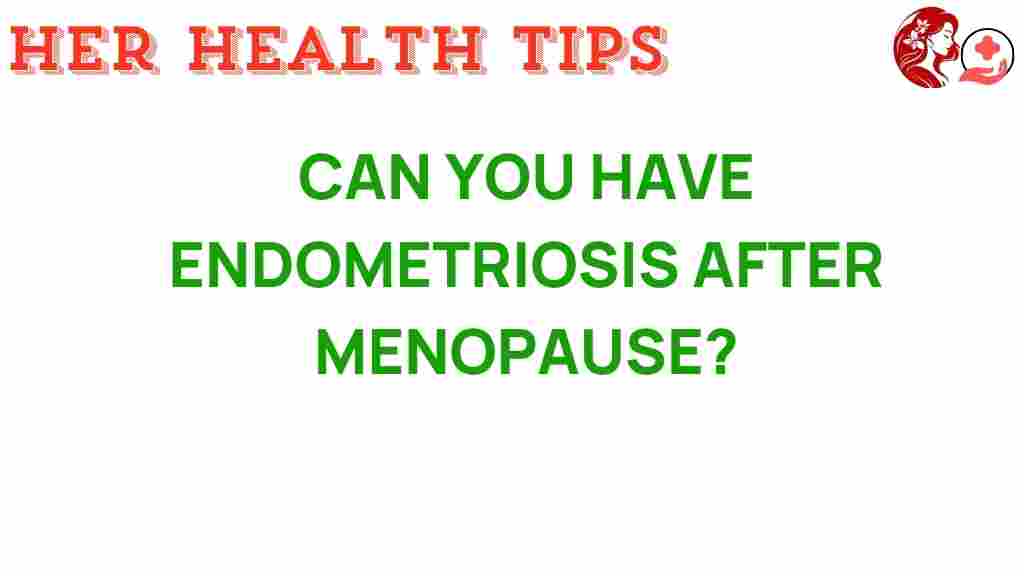Unraveling the Mystery: Can You Have Endometriosis After Menopause?
When it comes to women’s health, endometriosis is a term that often raises questions and misconceptions. Many women believe that once they reach menopause, they can no longer experience this condition. However, emerging research suggests that this may not be the case. In this article, we’ll explore the relationship between endometriosis and menopause, the symptoms, diagnosis, and treatment of this condition, as well as some common misconceptions surrounding it.
Understanding Endometriosis and Menopause
Endometriosis is a chronic condition where tissue similar to the lining of the uterus grows outside the uterus, often causing severe pelvic pain and other symptoms. This condition is typically associated with the reproductive years, but what happens when a woman reaches menopause?
The Impact of Hormonal Changes
Menopause signifies the end of a woman’s reproductive years, marked by a decline in estrogen levels. Estrogen plays a crucial role in the growth and maintenance of endometrial tissue. Many women believe that since estrogen levels drop significantly during menopause, endometriosis symptoms should also dissipate. However, hormonal changes can be complex and may not completely eliminate endometriosis.
Can You Have Endometriosis After Menopause?
The short answer is yes; it is possible to have endometriosis after menopause. Although the prevalence decreases, some women may continue to experience symptoms or may even develop new lesions due to hormonal therapy or other factors. Here’s how:
- Hormone Replacement Therapy (HRT): Some women undergoing HRT may experience a resurgence of endometriosis symptoms as estrogen can promote the growth of endometrial-like tissue.
- Residual Tissue: If endometriosis was present before menopause, residual tissue may continue to cause pain and discomfort, even after hormonal changes.
- Misdiagnosis: Symptoms of other conditions may mimic those of endometriosis, leading to misdiagnosis and ongoing pain.
Symptoms of Endometriosis After Menopause
Recognizing the symptoms of endometriosis after menopause is essential for timely diagnosis and treatment. Common symptoms include:
- Pain: Persistent pelvic pain, which may vary in intensity.
- Bleeding: Unexplained bleeding or spotting.
- Digestive Issues: Symptoms like bloating, constipation, or diarrhea may occur.
- Urinary Symptoms: Difficulty urinating or increased frequency may be observed.
If you notice any of these symptoms post-menopause, it’s crucial to consult with a healthcare provider for a thorough evaluation.
Diagnosis of Endometriosis After Menopause
Diagnosing endometriosis, especially after menopause, can be challenging. The following steps are typically involved:
- Medical History: Your doctor will take a detailed medical history, including symptoms and any previous diagnoses.
- Physical Examination: A pelvic exam may help identify any abnormalities.
- Imaging Tests: Ultrasounds or MRIs can provide insight into the presence of endometrial-like tissue.
- Laparoscopy: In some cases, a laparoscopic procedure may be necessary for a definitive diagnosis.
Common Misconceptions About Endometriosis and Menopause
Several misconceptions persist regarding endometriosis and menopause that can lead to confusion for many women:
- Myth 1: Endometriosis only affects women of childbearing age.
- Myth 2: Once menopause occurs, endometriosis is no longer a concern.
- Myth 3: All pelvic pain after menopause is due to other conditions, not endometriosis.
Understanding these misconceptions is crucial for women’s health and ensuring that they seek the appropriate care when needed.
Treatment Options for Endometriosis After Menopause
Treating endometriosis after menopause can vary based on the severity of symptoms and the overall health of the patient. Common treatment options include:
- Hormonal Therapy: For some women, adjusting hormone therapy or using medications that suppress estrogen may alleviate symptoms.
- Surgery: Surgical options to remove endometrial-like tissue may be recommended if symptoms are severe.
- Pain Management: Over-the-counter pain relievers or prescribed medications can help manage discomfort.
- Alternative Therapies: Some patients find relief through acupuncture, dietary changes, or physical therapy.
Step-by-Step Process for Managing Symptoms
For women experiencing endometriosis after menopause, managing symptoms can be approached in a systematic way:
- Track Symptoms: Keep a journal of symptoms to discuss with your healthcare provider.
- Consult a Specialist: Seek a gynecologist or specialist in endometriosis for targeted care.
- Discuss Treatment Options: Explore hormonal and non-hormonal treatment options tailored to your needs.
- Implement Lifestyle Changes: Consider dietary adjustments, exercise, and stress management techniques.
Troubleshooting Tips for Managing Endometriosis
Managing endometriosis after menopause may come with its challenges. Here are some troubleshooting tips:
- Stay Informed: Educate yourself about endometriosis and stay updated on new research and treatment options.
- Seek Support: Join support groups or forums where you can share experiences and gain insights from others.
- Communicate with Healthcare Providers: Be open about your symptoms and treatment responses during appointments.
- Practice Self-Care: Engage in activities that reduce stress and promote overall well-being, such as yoga or meditation.
Conclusion
In conclusion, while endometriosis is often associated with the reproductive years, it can persist or even emerge after menopause. Understanding the symptoms, diagnosis, and treatment options is crucial for women’s health. By debunking misconceptions and ensuring that women are aware of their health post-menopause, we can empower them to seek the care they need. If you are experiencing pelvic pain or other symptoms after menopause, do not hesitate to consult a healthcare professional for guidance. Remember, being informed is the first step towards effective management and achieving a better quality of life.
For more information on women’s health and endometriosis, you can visit this resource.
This article is in the category Reproductive and created by HerHealthTips Team
